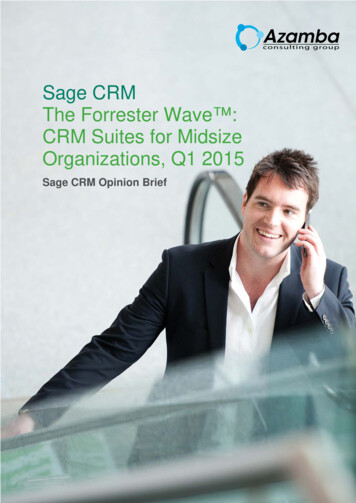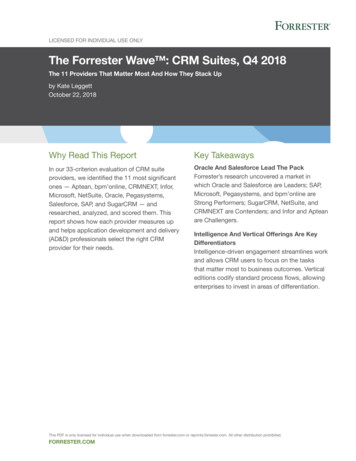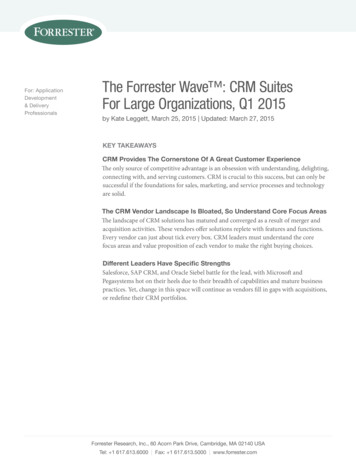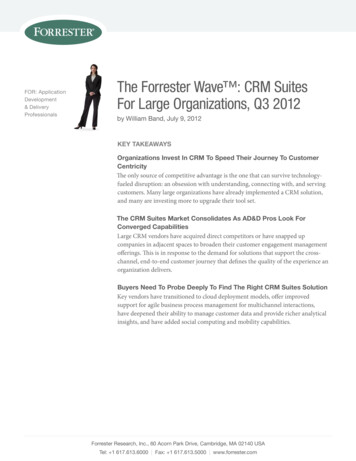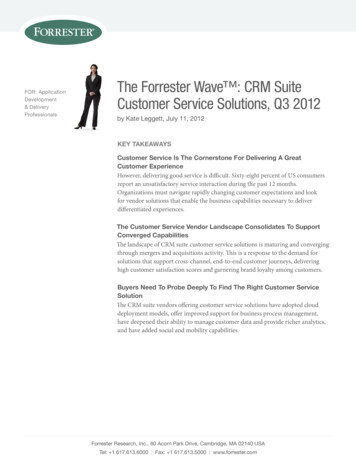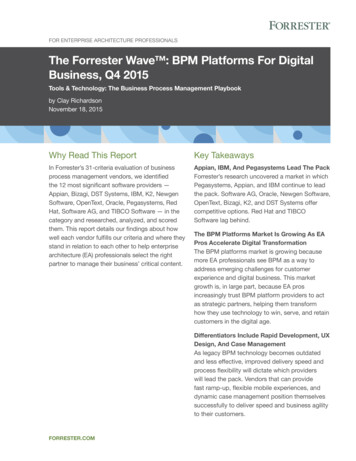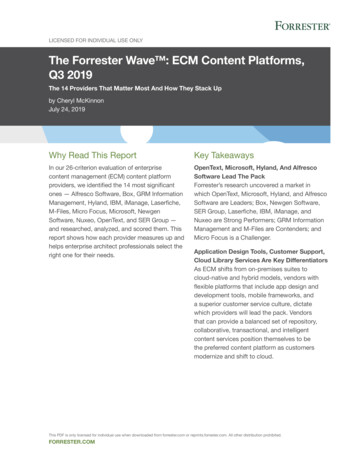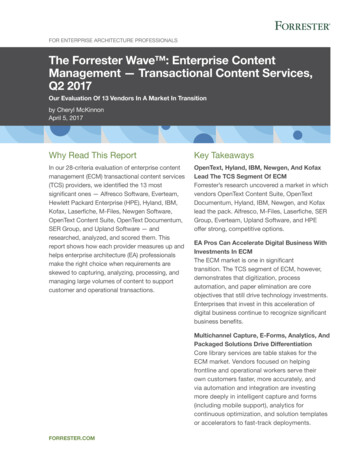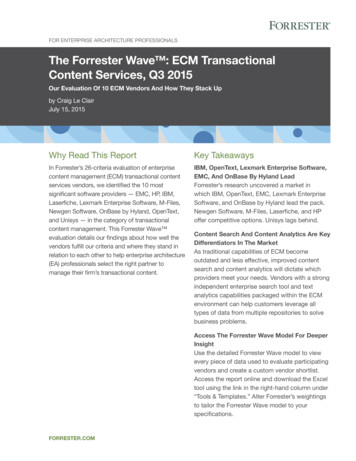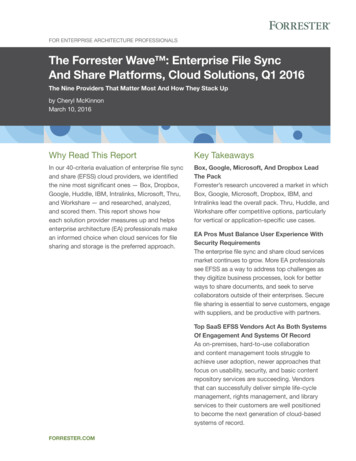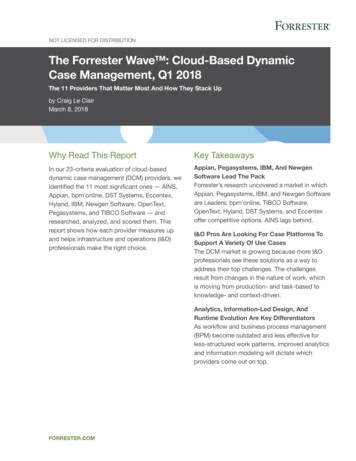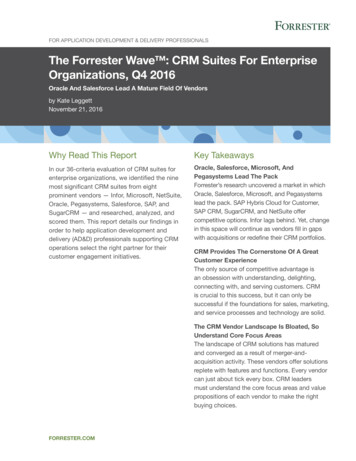
Transcription
For Application Development & Delivery ProfessionalsThe Forrester Wave : CRM Suites For EnterpriseOrganizations, Q4 2016Oracle And Salesforce Lead A Mature Field Of Vendorsby Kate LeggettNovember 21, 2016Why Read This ReportKey TakeawaysIn our 36-criteria evaluation of CRM suites forenterprise organizations, we identified the ninemost significant CRM suites from eightprominent vendors — Infor, Microsoft, NetSuite,Oracle, Pegasystems, Salesforce, SAP, andSugarCRM — and researched, analyzed, andscored them. This report details our findings inorder to help application development anddelivery (AD&D) professionals supporting CRMoperations select the right partner for theircustomer engagement initiatives.Oracle, Salesforce, Microsoft, AndPegasystems Lead The PackForrester’s research uncovered a market in whichOracle, Salesforce, Microsoft, and Pegasystemslead the pack. SAP Hybris Cloud for Customer,SAP CRM, SugarCRM, and NetSuite offercompetitive options. Infor lags behind. Yet, changein this space will continue as vendors fill in gapswith acquisitions or redefine their CRM portfolios.CRM Provides The Cornerstone Of A GreatCustomer ExperienceThe only source of competitive advantage isan obsession with understanding, delighting,connecting with, and serving customers. CRMis crucial to this success, but it can only besuccessful if the foundations for sales, marketing,and service processes and technology are solid.The CRM Vendor Landscape Is Bloated, SoUnderstand Core Focus AreasThe landscape of CRM solutions has maturedand converged as a result of merger-andacquisition activity. These vendors offer solutionsreplete with features and functions. Every vendorcan just about tick every box. CRM leadersmust understand the core focus areas and valuepropositions of each vendor to make the rightbuying choices.forrester.com
For Application Development & Delivery ProfessionalsThe Forrester Wave : CRM Suites For Enterprise Organizations,Q4 2016Oracle And Salesforce Lead A Mature Field Of Vendorsby Kate Leggettwith Stephen Powers, Mark Grannan, Sara Sjoblom, Chad Rafferty, and Peter HarrisonNovember 21, 2016Table Of Contents2 Modern CRM Supports Customers In TheirEnd-To-End Journeys3 The CRM Market Continues To Mature4 CRM Innovations Go Deep And Broad4 More Is Not Better In The CRM Market —Sometimes More Is Worse8 CRM Suites For Enterprise OrganizationsEvaluation Overview11 Vendor ProfilesNotes & ResourcesForrester conducted vendor surveys in Augustand September 2016 and evaluated nine CRMsolutions worthy of consideration by largeorganizations: Infor CRM, Microsoft DynamicsCRM, NetSuite CRM, Oracle CX Cloud Suite,Pega CRM, Salesforce, SAP CRM, SAP HybrisCloud for Customer, and SugarCRM. We alsointerviewed vendor customers.Related Research DocumentsNavigate The Future Of CRM In 201618 Supplemental MaterialTechRadar : The Extended CRM TechnologyEcosystem, Q4 2015Transform Customer Processes And Systems ToImprove ExperiencesForrester Research, Inc., 60 Acorn Park Drive, Cambridge, MA 02140 USA 1 617-613-6000 Fax: 1 617-613-5000 forrester.com 2016 Forrester Research, Inc. Opinions reflect judgment at the time and are subject to change. Forrester ,Technographics , Forrester Wave, RoleView, TechRadar, and Total Economic Impact are trademarks of ForresterResearch, Inc. All other trademarks are the property of their respective companies. Unauthorized copying ordistributing is a violation of copyright law. Citations@forrester.com or 1 866-367-7378
For Application Development & Delivery ProfessionalsNovember 21, 2016The Forrester Wave : CRM Suites For Enterprise Organizations, Q4 2016Oracle And Salesforce Lead A Mature Field Of VendorsModern CRM Supports Customers In Their End-To-End JourneysForrester defines CRM as:The business processes and supporting technologies that support the key activities of targeting,acquiring, retaining, understanding, and collaborating with customers.Companies leverage CRM to provide operational efficiencies for sales, marketing, and customerservice organizations when they interact with customers — an “inside-out” approach. They useit to analyze opportunity and customer data as well as automate workflows to optimize customerengagement processes. To quantify CRM’s return on investment, companies examine operationalmetrics such as marketing costs, revenue from salespeople, sale cycle times, pipeline visibility, andservice resolution times. Because of these operational successes, two-thirds of technology decisionmakers at enterprise organizations have implemented a subset of CRM capabilities (see Figure 1).1Today, forward-thinking AD&D pros build on these internal operational efficiencies and extend thepower of CRM to better support the end-to-end customer journey. Good customer experiencescorrelate to retention loyalty, enrichment loyalty, and advocacy loyalty. Our models estimate that therevenue impact of a 10-percentage-point improvement in a company’s performance, as measured byForrester’s Customer Experience Index (CX Index ) score, could exceed 1 billion.2 2016 Forrester Research, Inc. Unauthorized copying or distributing is a violation of copyright law.Citations@forrester.com or 1 866-367-73782
For Application Development & Delivery ProfessionalsNovember 21, 2016The Forrester Wave : CRM Suites For Enterprise Organizations, Q4 2016Oracle And Salesforce Lead A Mature Field Of VendorsFIGURE 1 Many Enterprises Have Already Implemented A CRM SolutionShare of decision-makers who are planning, implementing, or have alreadyimplemented CRM subsetsImplemented/expandingCustomer service and supportSales force automationMarketing automationPlanning toimplement55%57%54%Not planning/don’t know20%18%20%Base: 2,858 global software technology decision-makers and business decision-makers whose firmsprioritize the specified technology solutionSource: Forrester’s Global Business Technographics Software Survey, 2015The CRM Market Continues To MatureThe CRM market has consolidated in the past five years. Oracle has built its customer experienceportfolio primarily by acquisition.3 SAP, like Oracle, aims to support end-to-end customer experiencesand has made acquisitions — notably, Hybris in 2013 — to bolster its capabilities.4 Salesforce made aseries of moves to strengthen the Service Cloud.5 It used this same tactic to broaden its CRM footprintwith the acquisition of Demandware for eCommerce in 2016. Other notable acquisitions include Infor’sacquisition of Saleslogix (2014) from Swiftpage and Microsoft’s acquisitions of Parature (2014) forcustomer service and FieldOne (2015) for field service.These acquisitions broaden and deepen the footprints of large vendors, but these vendors must spendtime integrating acquired products, offering common user experiences as well as common businessanalyst and administrator tooling — priorities that can conflict with core feature development.Point Solution Vendors Go After The Enterprise PlayersLarge CRM vendors increasingly offer broader and deeper capabilities that bloat their footprints andincrease their complexity with features that many users can’t leverage. At the same time, new pointsolution vendors are quickly popping up, and they deliver modern interfaces and mobile-first strategiesthat address specific business problems such as sales performance management, lead-to-revenuemanagement, and digital customer experience. Of course, these vendors have a long way to go toprove their capabilities in an enterprise setting. 2016 Forrester Research, Inc. Unauthorized copying or distributing is a violation of copyright law.Citations@forrester.com or 1 866-367-73783
For Application Development & Delivery ProfessionalsNovember 21, 2016The Forrester Wave : CRM Suites For Enterprise Organizations, Q4 2016Oracle And Salesforce Lead A Mature Field Of VendorsKeep an eye on this space, and choose vendors carefully, as the CRM landscape is going through a lotof change.CRM Innovations Go Deep And BroadThe nine vendor solutions we included in this Forrester Wave evaluation reported a total of about200,000 customers, with strong penetration in large enterprises. We see that the shift to softwareas-a-service (SaaS) is well underway. Forrester Data shows that a third of enterprises are using SaaSCRM, and another third complement their existing solutions with SaaS. We expect SaaS to becomethe primary deployment model for CRM and that newer SaaS solutions will replace most on-premisesinstallations in the next five years.6 In addition to SaaS, technology innovation in the CRM vendorlandscape is evolving along several other vectors:›› Intelligence takes center stage. Large organizations that manage huge volumes of data struggleto pinpoint optimal offers, discount levels, product bundles, and next best steps for customerengagement. They increasingly turn to analytics to uncover insight and prescribe the right actionfor the business user to take. Today, leading vendors offer a range of packaged capabilities toinfuse decisioning in customer-facing interactions.›› Vendors increasingly invest in vertical editions. Horizontal CRM can only take you so far,as different industries have different requirements for engaging with customers. CRM vendorsincreasingly offer solutions — templates, common process flows, data model extensions, and UIlabels — pertinent to specific industries. These solutions allow enterprises to focus on capabilitiesthat differentiate them in the marketplace instead of on core industry capabilities that should betable stakes. In this Forrester Wave evaluation, we find that all vendors either offer a broad range ofvertical solutions or have invested in deep domain expertise and a vertical go-to-market approach.›› Customer success rises to the top. In a mature market, you have to dig deep to find realdifferences between vendor offerings. CRM success depends on the right choice of consultingpartners to implement and integrate your solution. CRM vendors are maturing their consultingservices, deeply investing in growing regional and global strategic services partners, and investingin customer success to properly onboard customers and actively manage customer relationships.This preserves a company’s revenue stream by reducing churn, expands revenue by increasingcustomer lifetime value, and can influence new sales via customer advocacy efforts.More Is Not Better In The CRM Market — Sometimes More Is WorseEach of the leading vendors in this mature market offers a checklist of features and functions.Remember that more is not necessarily better; many times more is just more. In fact, when you don’tneed or can’t use extra features, more is sometimes worse. CRM buyers must understand the marketsegmentation in order to focus in on the right category of vendor that is the right size for their needs. 2016 Forrester Research, Inc. Unauthorized copying or distributing is a violation of copyright law.Citations@forrester.com or 1 866-367-73784
For Application Development & Delivery ProfessionalsNovember 21, 2016The Forrester Wave : CRM Suites For Enterprise Organizations, Q4 2016Oracle And Salesforce Lead A Mature Field Of VendorsAsk What Size Organization Each Vendor TargetsEven with market consolidation, CRM solutions fall into four primary groups to choose from —although the distinctions between these categories have become less pronounced over the past threeyears (see Figure 2):›› CRM suites for large organizations. CRM vendors focused on large organizations —organizations with 1,000 or more employees — typically offer a full range of functionality supportingmultiple languages and geographies. They also offer vertical solutions and have companyresources dedicated to their support and customer success. Vendors in this category also targetmidsize organizations, offering prepackaged, rapidly implemented versions of their solutions withmore affordable price tags. The leading vendors in this category are highlighted in this report.›› CRM suites for midsize organizations. Vendors primarily target these solutions to organizations ordivisions of larger enterprises with 250 to 999 employees. They often have more limited capabilitiesin specific areas and are simpler to use than solutions built for the enterprise market. Some vendorsin this category have upgraded their solutions to be more suitable to enterprise-class buyers and aregaining acceptance in that segment as well. We highlight the leading vendors in this category in thisForrester Wave’s companion evaluation of CRM suites for midsize organizations.7›› CRM suites for small organizations. These vendors primarily target organizations with up to 250employees. Functionality is limited compared with what full CRM suite solutions offer and typicallyfocuses on basic contact and account management, delivered via mobile-first user experiences;core marketing; and customer service capabilities for individuals or small teams.›› CRM specialty solutions. This category comprises vendors that offer solutions with narrowfunctional breadth but deep specialty capabilities — such as marketing automation and customerservice — for both large and midmarket organizations. This category also includes CRM vendorsthat specialize in specific industries such as financial services, life sciences, telecommunications,and the not-for-profit sector.8 2016 Forrester Research, Inc. Unauthorized copying or distributing is a violation of copyright law.Citations@forrester.com or 1 866-367-73785
For Application Development & Delivery ProfessionalsNovember 21, 2016The Forrester Wave : CRM Suites For Enterprise Organizations, Q4 2016Oracle And Salesforce Lead A Mature Field Of VendorsFIGURE 2 CRM Solutions Fall Into Four Distinct CategoriesExamples of CRM suites for large organizationsCRM suites primarily designed for firms with1,000 employees or more Infor CRM Microsoft Dynamics CRM* NetSuite Oracle CX Pegasystems CRM Salesforce* SAP CRM SAP Hybris Cloud for Customer SugarCRM*Examples of CRM suites for small organizations Base CRM Capsule CRM GoldMine CRM Infusionsoft Nimble Swiftpage Act ZohoExamples of CRM specialty solutionsExamples of CRM suites for midsize organizationsCRM suites primarily designed for firms with250 to 999 employeesCustomer service solutions eGain Freshdesk Verint Systems Zendesk Aptean Pivotal CRM bpm’online Bullhorn IBM Campaign Infor CRM Infor Epiphany Marketing Maximizer CRM SAS Customer Intelligence Microsoft Dynamics CRM* Teradata Integrated Marketing Cloud NetSuite Oracle CXCustomer marketing automation solutionsAdobe CampaignIndustry specialist solutionsAmdocs CES Customer RelationshipManagement (telecommunications) Sage CRM Salesforce* SAP Hybris Cloud for Customer SugarCRM* Blackbaud (not-for-profits) IMS Health (life sciences) NexJ Systems (financial services) StayinFront (life sciences) Veeva Systems (life sciences)*These vendors have a significant base of both midmarket and enterprise customers. 2016 Forrester Research, Inc. Unauthorized copying or distributing is a violation of copyright law.Citations@forrester.com or 1 866-367-73786
For Application Development & Delivery ProfessionalsNovember 21, 2016The Forrester Wave : CRM Suites For Enterprise Organizations, Q4 2016Oracle And Salesforce Lead A Mature Field Of VendorsFactor Size, Complexity, And Business Model Into Your CRM DecisionThe CRM needs of a B2B company are not the same as the needs of a B2C company. Likewise, theneeds of a sales organization are not the same as those of a customer service organization. Carefullyreview the Forrester Wave evaluation criteria to pick a solution that is the right size for your needs. Inmany cases, too many features can be overkill for enterprise organizations with lightweight needs.Consider a number of capabilities to rightsize for strategy (see Figure 3).FIGURE 3 Rightsize Your CRM For Your NeedsCategoryConsider your requirements to supportSales force automation ManagementMarketing automationCustomer serviceField serviceeCommerceBusiness intelligenceof complex, parallel sales processes, includingquote-to-order and renewals Complex team, territory, and commissions management processes Prescriptive advice to increase sales productivity Marketing resource management needs Complex, multistage, and recurring campaigns Complex lead-management workflows Online and offline communication channels Offer management, including analytics to optimize offers Computer telephony integration Case management Omnichannel communications Agent guidance for scripted processes Knowledge management for agents and customers Core field service needs (dispatch, scheduling, service ordermanagement) Spare parts management Warranty management Mobile support for field employees Transactional features (shopping cart, search, promotions,personalization) Order management Returns/exchanges Reports and dashboards Advanced analytics capabilities, including predictive modeling,simulations, and statistical analysis 2016 Forrester Research, Inc. Unauthorized copying or distributing is a violation of copyright law.Citations@forrester.com or 1 866-367-73787
For Application Development & Delivery ProfessionalsNovember 21, 2016The Forrester Wave : CRM Suites For Enterprise Organizations, Q4 2016Oracle And Salesforce Lead A Mature Field Of VendorsEvaluate The Level Of Integration And Consistency Across The CRM SuiteMany CRM vendors have built up their current suites via acquisition. This has meant that CRM usersface disconnected applications with differing user experiences, integrations, and processes. Manycustomers will accept some differences in order to reduce the number of vendor relationships that theymanage. Yet, if CRM suites are to be truly successful, CRM must deliver consistent user experiences,business and administrator tooling, processes and workflows, security, permissions, and more acrossthe suite. Consider these factors as you perform your evaluation.CRM Suites For Enterprise Organizations Evaluation OverviewTo assess the state of the enterprise CRM suite market and see how the vendors stack up againsteach other, Forrester evaluated the strengths and weaknesses of top CRM suites for enterpriseorganizations. After examining past research, user need assessments, and vendor and expertinterviews, we developed a comprehensive set of evaluation criteria. Forrester evaluated each vendoragainst 36 criteria, which we categorized into the following three areas:›› Current offering. Each vendor’s position on the vertical axis of the Forrester Wave graphicindicates the strength of its current product offering. We looked at the strength of each vendor’sproducts across a spectrum of CRM capabilities: sales force automation, marketing automation,customer service, field service, eCommerce, business intelligence, and platform and architecture.›› Strategy. A vendor’s position on the horizontal axis of the Forrester Wave graphic indicates ourassessment of its strategy. We assessed the strength of each vendor’s product strategy, executionroad map, go-to-market approach, supporting services, third-party ecosystem, and pricingtransparency. We also interviewed customer references to evaluate the success that they have hadusing each suite we evaluated.›› Market presence. The size of each vendor’s bubble on the Forrester Wave graphic indicates itsmarket presence. We gauged the size of each vendor’s customer base in terms of the number oflive installations and number of users.Evaluated Vendors And Inclusion CriteriaWe included nine solutions in our assessment of CRM suites for enterprise organizations: Infor CRM,Microsoft Dynamics CRM, NetSuite CRM, Oracle CX Cloud Suite, Pega CRM, Salesforce, SAP CRM,SAP Hybris Cloud for Customer, and SugarCRM. We did not assess solutions focused on a singleindustry or vendors that specialize in a subset of CRM functionalities, such as standalone sales forceautomation vendors, customer service vendors, or marketing automation vendors.Each ven
the Forrester Wave : crm suites For enterprise organizations, Q4 2016 November 21, 2016 2016 Forrester Research, Inc. Unauthorized copying or distributing is a violation of copyright law. Citationsforrester.com or 1 866-367-7378 3 Oracle And Salesforce Lead A Mature Field Of Vendors FIGURE 1 many enterprises Have Already implemented A crm .File Size: 505KB
